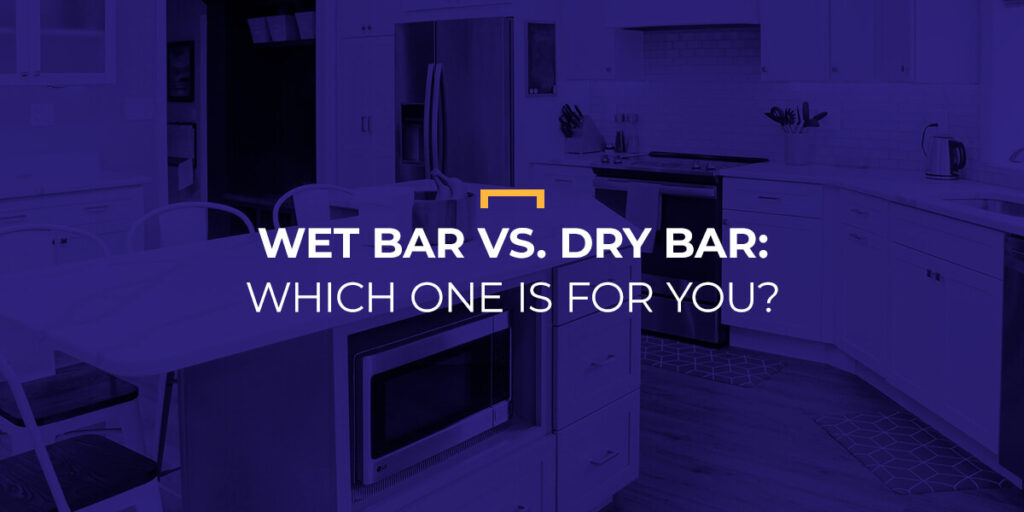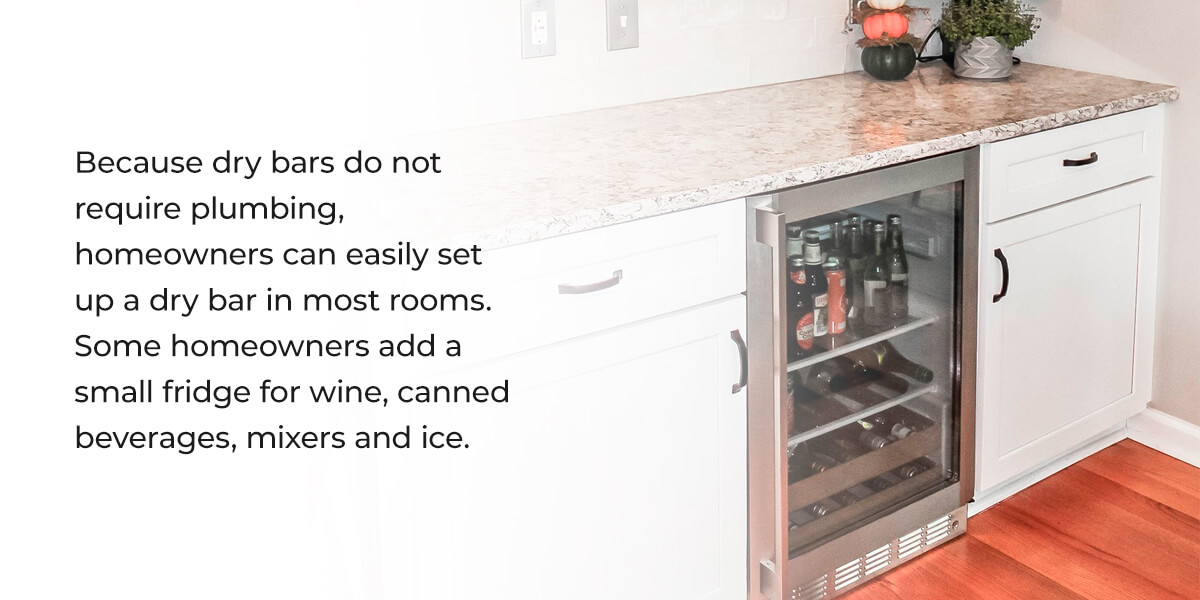
Wet Bar vs. Dry Bar: Which One Is for You?
- Home
- Wet Bar vs. Dry Bar: Which One Is for You?

A home bar makes it much easier to prepare drinks, entertain and add resale value to your home. You have options between a wet bar and a dry bar. Understand the key differences between the two bar options to help you determine which one makes sense for your space and style.
Dry bars and wet bars both add functionality and style to your home. They create a counter space that provides plenty of room for you to prepare drinks and store things like liquor, mixers and bar supplies.
While both bar options simplify the process of entertaining guests and serving drinks, there are differences to consider before installing one in your residence. Simply put, a wet bar has a sink with running water. A dry bar is a preparation space with no sink.
A wet bar is a bar located inside or outside of a home with a sink, countertop and cabinetry. Wet bars are used for:
Typical wet bar locations include basements, dining areas, entertainment rooms and covered outdoor patios — anywhere individuals may gather to eat food, play games or relax.

A dry bar does not have the “wet” component of a sink or plumbing. Dry bars usually include cabinet storage for bottles, drinkware and tools in addition to a countertop area to prepare drinks.
Because dry bars do not require plumbing, homeowners can easily set up a dry bar in most rooms. Some homeowners add a small fridge for wine, canned beverages, mixers and ice.
A dry bar offers a practical solution for storing empty glasses and liquors but doesn’t offer the utility of a wet bar. Consider the top benefits and challenges of installing a wet bar to see whether it is the right home improvement choice for you.
Once you learn what a wet bar is, you might find yourself brainstorming ways to make the investment a part of your new build or home upgrades. Adding a luxurious element to your living spaces can boost your property value.
Wet bars need access to plumbing, which requires room to run water lines. For this reason, wet bars are typically installed in large, spacious areas of a home.
A well-designed wet bar means everything is available in one place, including the sink. High-quality bar cabinets maximize every inch so you can find specific glasses, spirits and tools in seconds.
While a dry bar can be added just about anywhere, wet bars must have plumbing hookups for the sink. Installing a wet bar may also require permission from building authorities, permits, electrical lines, contractors and a longer construction time. For a full wet bar experience with professional-grade drink machines, bar taps and other bar appliances, you may need to run additional water lines.
If you plan to DIY your wet bar, it’s easier to complete an installation near existing electrical and plumbing hookups. Otherwise, expect more complicated plumbing and electrical preparation, by yourself or a professional contractor, before placing the final cabinets, sink and countertops.
After a long work week, it’s nice to have the option of making your favorite drinks and unwinding in the comfort of your own home. Sink access to chilled water allows you to create a wide array of complex beverages quickly and easily.
If you love to socialize, keep in mind that cleaning up as you entertain comes with the territory of wet bars. Having a wet bar also means you’ll likely spend quite a bit of time mixing drinks behind the counter when you have friends over for cocktails.
As guests return their glasses to the bar and ask for new beverages, it’s best not to let glassware pile up in the sink. Plan to periodically wipe down the bar, wash pitchers and rinse glasses while friends mingle.
For some, this may be a pro of wet bars. With a dry bar, you’d need to take everyone’s glasses away to the kitchen to clean up, taking you away from the party.
Even if you don’t intend to work professionally as a bartender, practicing recipes at home will increase your mixology knowledge so you can pour better drinks when entertaining. With a home wet bar, you can show off your skills and impress your guests with delicious beverages at hangouts.
When hosting large gatherings such as graduation parties or wedding showers, consider having another person prepare beverages behind the bar. Having a family member help or hiring a bartender for the occasion can ensure you have time to greet everyone, socialize and have a good time.
While a simple wet bar setup may not significantly affect maintenance costs, the more elaborate your bar, the more expensive upkeep can be. Commercial juicers, blending systems, margarita makers, beer dispensers and other wet bar appliances increase financial maintenance beyond the initial cost of installation. Regular upkeep also means purchasing new filters for water lines and replacing parts as needed.
Depending on how often you entertain, you can expect an increase in your water utility bill from sink usage and any additional water lines. If you have a keg refrigerator, fridge or special lighting, your electricity costs may also increase.
After learning what a dry bar is, you may wonder if it’s an ideal option for your lifestyle and home layout. Evaluate these pros and cons to determine if the setup will suit your needs.
Save time and money when you choose a dry bar. The setups don’t require sinks or plumbing fixtures, making them an efficient and cost-effective way to complete your project.
Dry bars are ideal for drinks that have little to no preparation and don’t require mixing. The setups work well for many non-alcoholic beverages such as coffee and tea.
Homeowners can have peace of mind with a dry bar. The setup doesn’t require plumbing inspections, maintenance, repairs or replacements over time.
Dry bars are a popular choice for many households. Because the setups are more common and feature fewer amenities, they have a more subtle “wow” factor than wet bars.
Which type of bar is right for you all depends on how you’d like to use the space.
Do you love to be the life of the party, mixing tropical drinks for the neighborhood on Friday nights? Or do you prefer pouring drinks for two to unwind by the fire with your partner?
Wet bars are more convenient for preparing “messy” drinks, cleaning pitchers and entertaining large crowds, while dry bars are more suitable in smaller areas or when plumbing isn’t an option. There are still other options like breakfast bars you may want to keep in mind as well.
Dry bars usually have quick setups and require little to no upkeep. Decide how much you’re willing to spend on the installation and maintenance requirements of wet bar cabinets with sinks.
Professional designers can use state-of-the-art technology to help you visualize your wet or dry bar ideas. The bar counter should be at a comfortable height with enough depth to prepare and serve drinks. Enjoy seeing how elements such as cabinetry, shelves, bar stools and lounge chairs look together.
Our experts can recommend natural or engineered materials for your home bar. Choose surfaces matching your desired durability, appearance, brand and budget.
If you’re investing in a wet bar, automatic sink features and spray nozzles can make drink preparation and cleanup easier.
Whichever you choose, Bath, Kitchen & Tile is your factory-direct source for top-quality cabinets, countertops, hardware, appliances and sinks to complete your at-home wet or dry bar:
With our fit and competitive price guarantees, you can trust you’re getting the best products at the best prices with Bath, Kitchen & Tile. With showrooms conveniently located across Maryland and Delaware, we’re here to help you bring your vision to life.
Get started on your home improvement project today — contact us to receive a free quote and learn more about our products.